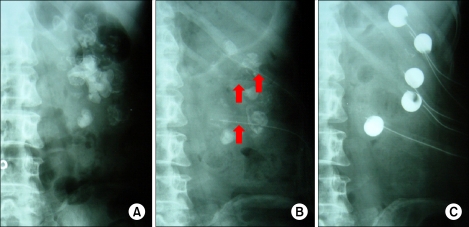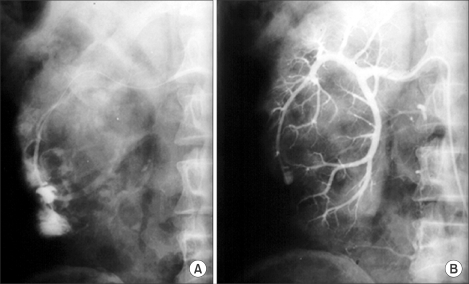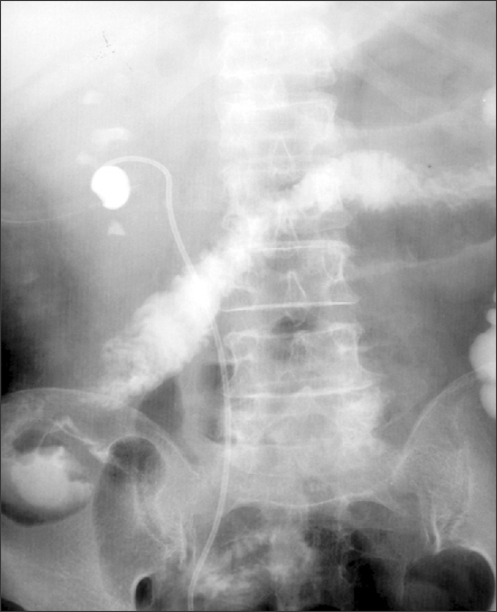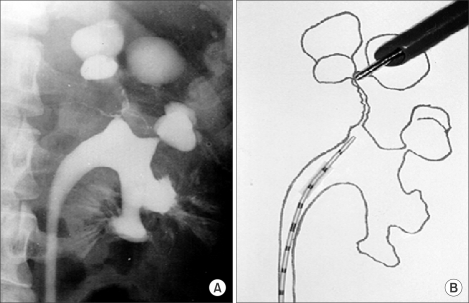Korean J Urol.
2010 May;51(5):298-307.
Percutaneous Nephroscopic Surgery
- Affiliations
-
- 1Department of Urology, Seoul St. Mary's Hospital, College of Medicine, The Catholic University of Korea, Seoul, Korea. tkhwang@catholic.ac.kr
Abstract
- With the development of techniques for percutaneous access and equipment to disintegrate calculi, percutaneous nephroscopic surgery is currently used by many urologists and is the procedure of choice for the removal of large renal calculi and the management of diverticula, intrarenal strictures, and urothelial cancer. Although it is more invasive than shock wave lithotripsy and retrograde ureteroscopic surgery, percutaneous nephroscopic surgery has been successfully performed with high efficiency and low morbidity in difficult renal anatomies and patient conditions. These advantages of minimal invasiveness were rapidly perceived and applied to the management of ureteropelvic junction obstruction, calyceal diverticulum, infundibular stenosis, and urothelial cancer. The basic principle of endopyelotomy is a full-thickness incision of the narrow segment followed by prolonged stenting and drainage to allow regeneration of an adequate caliber ureter. The preferred technique for a calyceal diverticulum continues to be debated. Excellent long-term success has been reported with percutaneous, ureteroscopic, and laparoscopic techniques. Each approach is based on the location and size of the diverticulum. So far, percutaneous ablation of the calyceal diverticulum is the most established minimally invasive technique. Infundibular stenosis is an acquired condition usually associated with inflammation or stones. Reported series of percutaneously treated infundibular stenosis are few. In contrast with a calyceal diverticulum, infundibular stenosis is a more difficult entity to treat with only a 50-76% success rate by percutaneous techniques. Currently, percutaneous nephroscopic resection of transitional cell carcinoma in the renal calyx can be applied in indicated cases.
Keyword
MeSH Terms
Figure
Reference
-
1. Hwang TK, Seo SI. Baba S, Ono Y, editors. Percutaneous access for urological disease. Recent advances in endourology. 2006. 8th ed. Japan: Springer;p. 25–39.
Article2. Gupta M, Ost MC, Shah JB, McDougall EM, Smith A. Wein AJ, Kavoussi LR, Novick AC, Partin AW, Peter CA, editors. Percutaneous management of the upper urinary tract. Campbell-Walsh urology. 2007. 9th ed. Philadelphia: Saunders;p. 1526–1563.3. Fernström I, Johansson B. Percutaneous pyelolithotomy. A new extraction technique. Scand J Urol Nephrol. 1976; 10:257–259. PMID: 1006190.4. Rupel E, Brown R. Nephroscopy with removal of stone following nephrostomy for obstructive calculous anuria. J Urol. 1941; 46:177–182.
Article5. Lingeman JE, Newmark JR, Wong MY. Smith AD, editor. Classification and management of staghorn calculi. Controversies in endourology. 1995. Philadelphia: Saunders;p. 136–144.6. Koh SK, Cho JP, Yoon DK, Cha IH. Percutaneous nephrolithotripsy. Korean J Urol. 1984; 25:739–745.7. Lee MS, Chung BH. Early experience of percutaneous nephrolithotomy. Korean J Urol. 1986; 27:417–423.8. Park CH, Lee SC. Percutaneous nephrolithotomy: clinical experience of 54 cases. Korean J Urol. 1986; 27:630–636.9. Lee JH, Lee YJ, Hwang TK, Park YH. Percutaneous nephrolithotomy: 57 cases. Korean J Urol. 1989; 30:41–47.10. Kukreja R, Desai M, Patel S, Bapat S, Desai M. Factors affecting blood loss during percutaneous nephrolithotomy: prospective study. J Endourol. 2004; 18:715–722. PMID: 15659890.11. Goh M, Wolf JS Jr. Almost totally tubeless percutaneous nephrolithotomy: further evolution of the technique. J Endourol. 1999; 13:177–180. PMID: 10360497.
Article12. Kader AK, Finelli A, Honey RJ. Nephroureterostomy-drained percutaneous nephrolithotomy: modification combining safety with decreased morbidity. J Endourol. 2004; 18:29–32. PMID: 15006049.
Article13. Deane LA, Clayman RV. Advances in percutaneous nephrostolithotomy. Urol Clin North Am. 2007; 34:383–395. PMID: 17678988.
Article14. Kessaris DN, Bellman GC, Pardalidis NP, Smith AG. Management of hemorrhage after percutaneous renal surgery. J Urol. 1995; 153:604–608. PMID: 7861493.
Article15. Carson CC. Complications of percutaneous stone extraction: prevention and treatment. Semin Urol. 1986; 4:161–169. PMID: 3749655.16. Mikhail AA, Kaptein JS, Bellman GC. Use of fibrin glue in percutaneous nephrolithotomy. Urology. 2003; 61:910–914. PMID: 12736002.
Article17. Shah HN, Kausik V, Hedge S, Shah JN, Bansal MB. Initial experience with hemostatic fibrin glue as adjuvant during tubeless percutaneous nephrolithotomy. J Endourol. 2006; 20:194–198. PMID: 16548728.
Article18. McDougall EM, Liatsikos EN, Dinlenc CZ, Smith AD. Walsh PC, Retik AB, Vaughan ED, Wein AJ, editors. Percutaneous approaches to the upper urinary tract. Campbell's urology. 2002. 8th ed. Philadelphia: Saunders;p. 3320–3360.19. Golijanin D, Katz R, Verstandig A, Sasson T, Landau EH, Meretyk S. The supracostal percutaneous nephrostomy for treatment of staghorn and complex kidney stones. J Endourol. 1998; 12:403–405. PMID: 9847059.
Article20. Munver R, Delvecchio FC, Newman GE, Preminger GM. Critical analysis of supracostal access for percutaneous renal surgery. J Urol. 2001; 166:1242–1246. PMID: 11547050.
Article21. Pardalidis N, Smith AD. Smith AD, editor. Complications of stone treatment. Controversies in endourology. 1995. Philadelphia: WB Saunders;p. 179–185.22. Wolf JS Jr. Management of intraoperatively diagnosed colonic injury during percutaneous nephrostolithotomy. Tech Urol. 1998; 4:160–164. PMID: 9800900.23. Lingeman JE, Matlaga BR, Evan AP. Wein AJ, Kavoussi LR, Novick AC, Partin AW, Peters CA, editors. Surgical management of upper urinary tract calculi. Campbell-Walsh urology. 2007. Philadelphia: Saunders;p. 1431–1507.24. Chatham JR, Dykes TE, Kennon WG, Schwartz BF. Effect of percutaneous nephrolithotomy on differential renal function as measured by mercaptoacetyl triglycine nuclear renography. Urology. 2002; 59:522–525. PMID: 11927303.
Article25. Morey AF, Nitahara KS, McAninch JW. Modified anatrophic nephrolithotomy for management of staghorn calculi: Is renal function preserved? J Urol. 1999; 162:670–673. PMID: 10458338.
Article26. Liou LS, Streem SB. Long-term renal functional effects of shock wave lithotripsy, percutaneous nephrolithotomy and combination therapy: a comparative study of patients with solitary kidney. J Urol. 2001; 166:36. PMID: 11435817.
Article27. Kerbl K, Rehman J, Landman J, Lee D, Sundaram C, Clayman RV. Current management of urolithiasis: progress or regress? J Endourol. 2002; 16:281–288. PMID: 12184077.
Article28. Albala DM, Assimos DG, Clayman RV, Denstedt JD, Grasso M, Gutierrez-Aceves J, et al. Lower pole I: a prospective randomized trial of extracorporeal shock wave lithotripsy and percutaneous nephrostolithotomy for lower pole nephrolithiasis-initial results. J Urol. 2001; 166:2072–2080. PMID: 11696709.
Article29. Badlani G, Eshghi M, Smith AD. Percutaneous surgery for ureteropelvic junction obstruction (endopyelotomy): technique and early results. J Urol. 1986; 135:26–28. PMID: 3941462.
Article30. Streem SB. Percutaneous endopyelotomy. Urol Clin North Am. 2000; 27:685–693. PMID: 11098767.
Article31. Lee MS, Yang SC, Choi YD, Chung BH. Endoscopic surgery for ureteropelvic junction obstruction. Korean J Urol. 1988; 29:83–88.32. Kim DY, Kwon SH, Chung SK, Kim BW, Park YK. Endopyelotomy as a treatment for ureteropelvic junction obstruction - 3 cases. Korean J Urol. 1988; 29:434–440.33. Danuser H, Ackermann DK, Böhlen D, Studer UE. Endopyelotomy for primary ureteropelvic junction obstruction: risk factors determine the success rate. J Urol. 1998; 159:56–61. PMID: 9400436.
Article34. Gupta M, Tuncay OL, Smith AD. Open surgical exploration after failed endopyelotomy: a 12-year perspective. J Urol. 1997; 157:1613–1618. PMID: 9112488.
Article35. Sampaio FJ. Vascular anatomy at the ureteropelvic junction. Urol Clin North Am. 1998; 25:251–258. PMID: 9633579.
Article36. Van Cangh PJ, Wilmart JF, Opsomer RJ, Abi-Aad A, Wese FX, Lorge F. Long-term results and late recurrence after endoureteropyelotomy: a critical analysis of prognostic factors. J Urol. 1994; 151:934–937. PMID: 8126829.
Article37. Gill IS, Desai MM, Kaouk JH, Wani K, Desai MR. Percutaneous endopyeloplasty: description of new technique. J Urol. 2002; 168:2097–2102. PMID: 12394717.
Article38. Desai MM, Desai MR, Gill IS. Endopyeloplasty versus endopyelotomy versus laparoscopic pyeloplasty for primary ureteropelvic junction. Urology. 2004; 64:16–21. PMID: 15245924.39. Hwang TK, Yoon JY, Ahn JH, Park YH. Percutaneous endoscopic management of upper ureteral stricture size of stent. J Urol. 1996; 155:882–884. PMID: 8583598.
Article40. Brooks JD, Kavoussi LR, Preminger GM, Schuessler WW, Moore RG. Comparison of open and endourologic approaches to the obstructed ureteropelvic junction. Urology. 1995; 46:791–795. PMID: 7502417.
Article41. Knudsen BE, Cook AJ, Watterson CD, Beiko DT, Nott L, Razvi H, et al. Percutaneous antegrade endopyelotomy: long-term results from one institution. Urology. 2004; 63:230–234. PMID: 14972459.
Article42. Shalhav AL, Giusti G, Elbahnasy AM, Hoenig DM, McDougall EM, Smith DS, et al. Adult endopyelotomy: impact of etiology and antegrade versus retrograde approach on outcome. J Urol. 1998; 160:685–689. PMID: 9720521.
Article43. Ost MC, Kaye JD, Guttman MJ, Lee BR, Smith AD. Laparoscopic pyeloplasty versus antegrade endopyelotomy: comparison in 100 patients and a new algorithm for the minimally invasive treatment of ureteropelvic junction obstruction. Urology. 2005; 66(5 Suppl):47–51. PMID: 16194707.
Article44. Canales B, Monga M. Surgical management of the calyceal diverticulum. Curr Opin Urol. 2003; 13:255–260. PMID: 12692451.
Article45. Kang JO, Lee DH, Hwang TK. Endourologic management of caliceal diverticula containing calculi. Korean J Urol. 1994; 35:543–547.46. Auge BK, Munver R, Kourambas J, Newman GE, Wu NZ, Preminger GM. Neoinfundibulotomy for the management of symptomatic caliceal diverticula. J Urol. 2002; 167:1616–1620. PMID: 11912375.
Article47. Landry JL, Colombel M, Rouviere O, Lezrek M, Gelet A, Dubernard JM, et al. Long term results of percutaneous treatment of caliceal diverticular calculi. Eur Urol. 2002; 41:474–477. PMID: 12074821.
Article48. Monga M, Smith R, Ferral H, Thomas R. Percutaneous ablation of caliceal diverticulum: long-term followup. J Urol. 2000; 163:28–32. PMID: 10604307.
Article49. Shalhav AL, Soble JJ, Nakada SY, Wolf JS Jr, McClennan BL, Clayman RV. Long-term outcome of caliceal diverticula following percutaneous endosurgical management. J Urol. 1998; 160:1635–1639. PMID: 9783921.
Article50. Kim JW, Seo SI, Hwang TK. Percutaneous treatment of caliceal diverticular stone. Korean J Urol. 2001; 42:180–184.51. Hwang TK, Park YH. Endoscopic infundibulotomy in tuberculous renal infundibular stricture. J Urol. 1994; 151:852–854. PMID: 8126808.
Article52. Sampaio FJ. Smith AD, Badlani GH, Bagley DH, Clayman RV, Jordan GH, Kavoussi LR, editors. Surgical anatomy of the kidney. Smith's textbook of endourology. 1996. St Louis: Quality Medical;p. 153–184.53. Han CH, Yang DK, Hwang TK, Park YH. Early experience of endoscopic infundibulotomy. Korean J Urol. 1991; 32:807–810.54. Lang EK. Percutaneous infundibuloplasty: management of calyceal diverticula and infundibular stenosis. Radiology. 1991; 181:871–877. PMID: 1947113.
Article55. Hwang TK, Seo SI, Kim JC, Yoon JY, Park YH, Yoon MS. Long-term results of percutaneous endourologic management of renal infundibular stricture. J Endourol. 1999; 13:495–498. PMID: 10569522.
Article56. Schneider AW, Conrad S, Busch R, Otto U. The cold-knife technique for endourological management of stenoses in the upper urinary tract. J Urol. 1991; 146:961–965. PMID: 1895451.
Article57. Soderdahl DW, Fabrizio MD, Rahman NU, Jarrett TW, Bagley DH. Endoscopic treatment of upper tract transitional cell carcinoma. Urol Oncol. 2005; 23:114–122. PMID: 15869996.
Article58. Box GN, Lehman DS, Landman J, Clayman RV. Minimally invasive management of upper tract malignancies: renal cell and transitional cell carcinoma. Urol Clin North Am. 2008; 35:365–383. PMID: 18761193.
Article59. Stewart GD, Bariol SV, Grigor KM, Tolley DA, McNeill SA. A comparison of the pathology of transitional cell carcinoma of the bladder and upper urinary tract. BJU Int. 2005; 95:791–793. PMID: 15794784.
Article60. Tasca A, Zattoni F. The case for a percutaneous approach to transitional cell carcinoma of the renal pelvis. J Urol. 1990; 143:902–904. PMID: 2329603.
Article61. Woodhouse CR, Kellett MJ, Bloom HJ. Percutaneous renal surgery and local radiotherapy in the management of renal pelvic transitional cell carcinoma. Br J Urol. 1986; 58:245–249. PMID: 3719242.
Article62. Orihuela E, Smith AD. Percutaneous treatment of transitional cell carcinoma of the upper urinary tract. Urol Clin North Am. 1988; 15:425–431. PMID: 3407033.
Article63. Lee BR, Jabbour ME, Marshall FF, Smith AD, Jarrett TW. 13-year survival comparison of percutaneous and open nephroureterectomy approaches for management of transitional cell carcinoma of renal collecting system: equivalent outcomes. J Endourol. 1999; 13:289–294. PMID: 10405908.
Article64. Jabbour ME, Smith AD. Primary percutaneous approach to upper urinary tract transitional cell carcinoma. Urol Clin North Am. 2000; 27:739–750. PMID: 11098771.
Article65. Lamm DL, Blumenstein BA, Crissman JD, Montie JE, Gottesman JE, Lowe BA, et al. Maintenance bacillus calmette-Guerin immunotherapy for recurrent TA, T1 and carcinoma in situ transitional cell carcinoma of the bladder: a randomized Southwest Oncology Group Study. J Urol. 2000; 163:1124–1129. PMID: 10737480.
Article





